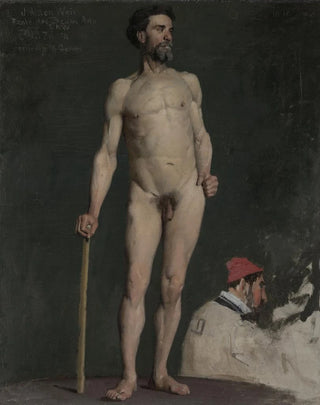Art print | Study of a male nude leaning on a stick - Julian Alden Weir


View from behind

Frame (optional)
"Study of a male nude leaning on a stick" by Julian Alden Weir presents itself as a delicate exploration of the human form, where the beauty of the male body is highlighted with remarkable finesse. This art print, capturing the very essence of the human figure, evokes both artistic sensitivity and undeniable technical mastery. Observing this piece, the viewer is immediately transported into a universe where contemplation and admiration intertwine, revealing the depth of the artistic representation of the body. Weir, with his unique approach, manages to infuse a vibrant life into his subject, allowing for a complete immersion into the scene.
Style and uniqueness of the art print
Julian Alden Weir's style is distinguished by meticulous attention to detail and a subtle use of light. In "Study of a male nude leaning on a stick," the model's posture, combined with the delicacy of shadows and highlights, creates an atmosphere of serenity and contemplation. The artist plays with nuances of flesh, rendering each curve and muscle in a way that feels both realistic and poetic. This blend of realism and idealization is a major characteristic of his work, where classical beauty is reflected in contemporary poses. Weir succeeds in capturing a moment of intimacy, a pause in time, where the observer is invited to appreciate the raw beauty of the human form without artifice.
The artist and his influence
Julian Alden Weir, an emblematic figure of the American Impressionist movement, knew how to mark his era with an innovative approach to painting. Influenced by masters like Monet and Degas, Weir incorporated elements of nature into his compositions while remaining faithful to the depiction of the human figure. His work on light and color paved the way for new perspectives in American art, inspiring many artists of his generation and beyond. By choosing to depict the male body in a posture that is both dynamic and contemplative, Weir challenged the conventions of his time, offering a refreshing and bold vision of masculinity. His legacy

Matte finish

View from behind

Frame (optional)
"Study of a male nude leaning on a stick" by Julian Alden Weir presents itself as a delicate exploration of the human form, where the beauty of the male body is highlighted with remarkable finesse. This art print, capturing the very essence of the human figure, evokes both artistic sensitivity and undeniable technical mastery. Observing this piece, the viewer is immediately transported into a universe where contemplation and admiration intertwine, revealing the depth of the artistic representation of the body. Weir, with his unique approach, manages to infuse a vibrant life into his subject, allowing for a complete immersion into the scene.
Style and uniqueness of the art print
Julian Alden Weir's style is distinguished by meticulous attention to detail and a subtle use of light. In "Study of a male nude leaning on a stick," the model's posture, combined with the delicacy of shadows and highlights, creates an atmosphere of serenity and contemplation. The artist plays with nuances of flesh, rendering each curve and muscle in a way that feels both realistic and poetic. This blend of realism and idealization is a major characteristic of his work, where classical beauty is reflected in contemporary poses. Weir succeeds in capturing a moment of intimacy, a pause in time, where the observer is invited to appreciate the raw beauty of the human form without artifice.
The artist and his influence
Julian Alden Weir, an emblematic figure of the American Impressionist movement, knew how to mark his era with an innovative approach to painting. Influenced by masters like Monet and Degas, Weir incorporated elements of nature into his compositions while remaining faithful to the depiction of the human figure. His work on light and color paved the way for new perspectives in American art, inspiring many artists of his generation and beyond. By choosing to depict the male body in a posture that is both dynamic and contemplative, Weir challenged the conventions of his time, offering a refreshing and bold vision of masculinity. His legacy






